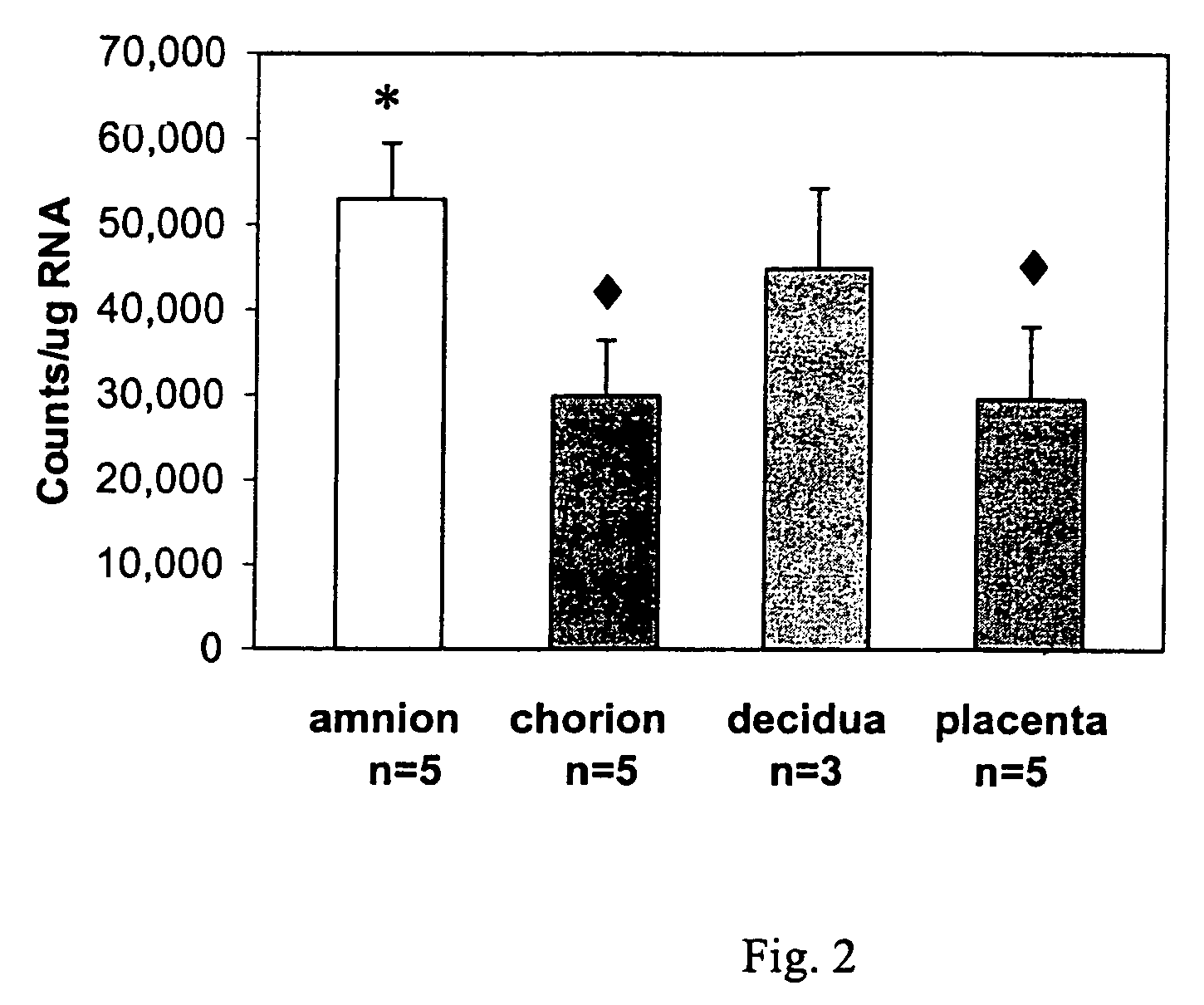Methods for diagnosing labor
a preterm labor and labor technology, applied in the field of preterm labor diagnosis and treatment, can solve the problems of limited sensitivity to further distension, and achieve the effect of good indicator of labor initiation
- Summary
- Abstract
- Description
- Claims
- Application Information
AI Technical Summary
Benefits of technology
Problems solved by technology
Method used
Image
Examples
example 1
Materials
[0040]Tissues for immunolocalization. Early pregnancy fetal membranes (87, 94 and 101 days gestation) were obtained after elective pregnancy termination and were kindly supplied by the Department of Pediatrics, University of Washington, Seattle. These tissues were dated by the day of the last menstrual period and collected within an hour of termination. They were collected with approval by the human subjects ERB of the University of Washington and shipped to Hawaii for use with no patient identification. Placentas and fetal membranes were also collected as soon as possible after delivery at Kapiolani Medical Center for Women and Children (Honolulu, Hi.) with informed consent and approval from the University Committee on Human Experimentation and the Hospital Institutional Review Board. These tissues were from patients after spontaneous preterm labor at 28-37 weeks gestation (n=4) and after normal spontaneous labor at term, 40-42 weeks gestation (n=4). Small pieces (3×3 cm) ...
example 2
Immunolocalization
[0047]Tissue sections (7 μm) were cut and mounted on Vectabond-treated slides (Vector Laboratories, Burlingame, Calif.), deparaffinized and hydrated in deionized water. They were treated with 0.3% hydrogen peroxide in methanol for 30 min to block endogenous peroxidase activity and washed in PBS for 20 min. Sections were treated with normal goat serum (1.5%) for 20 min to block all non-specific binding sites and then incubated with the IgG fraction derived from a rabbit polyclonal antibody to human PBEF (see Samal et al., supra) at 5 μg / ml in 0.5% normal goat serum at room temperature for 30 min. The negative controls were adjacent sections processed with IgG fraction derived from normal rabbit serum at the same concentration as the primary antibody. The sections were rinsed three times in 0.015 M PBS, 6 min total, then incubated with a biotinylated secondary antibody for 30 min, rinsed three times in 0.015 M PBS, 6 min total and treated with the ABC reagent (Vector...
example 3
Northern Analysis
[0049]Total RNA was extracted (see Chomzynski and Sacchi, supra) and MRNA prepared as previously described (see Aviv and Leder, supra). Samples of MRNA (10-20 μg) were electrophoresed, and the RNA transferred to a nylon membrane (Magna Graph, MSI, Westborough, Mass.) as previously described (see Ognjanovic et al., supra). The cDNA probes were labeled using the Random Primed DNA labeling kit and following the manufacturer's instructions (Invitrogen, Carlsbad, Calif.). The filters were hybridized at 68° C. for 1 h using Express Hyb solution (Clontech, Palo Alto, Calif., USA). A final wash stringency of 0.1×SSC, 0.1% SDS was performed at 50° C. Filters were deprobed in 0.5% SDS for 10 min at 100° C. and re-hybridized sequentially with cDNA probes to PBEF, IL-6 and IL-8 and finally with a human glyceraldehyde-3 phosphate dehydrogenase (G3PDH) cDNA probe (Clontech), as an internal standard. The Northern blot was quantitated with a Phospholmager (Amersham Pharmacia Biotec...
PUM
| Property | Measurement | Unit |
|---|---|---|
| optical density | aaaaa | aaaaa |
| pH | aaaaa | aaaaa |
| pH | aaaaa | aaaaa |
Abstract
Description
Claims
Application Information
 Login to View More
Login to View More - R&D
- Intellectual Property
- Life Sciences
- Materials
- Tech Scout
- Unparalleled Data Quality
- Higher Quality Content
- 60% Fewer Hallucinations
Browse by: Latest US Patents, China's latest patents, Technical Efficacy Thesaurus, Application Domain, Technology Topic, Popular Technical Reports.
© 2025 PatSnap. All rights reserved.Legal|Privacy policy|Modern Slavery Act Transparency Statement|Sitemap|About US| Contact US: help@patsnap.com



